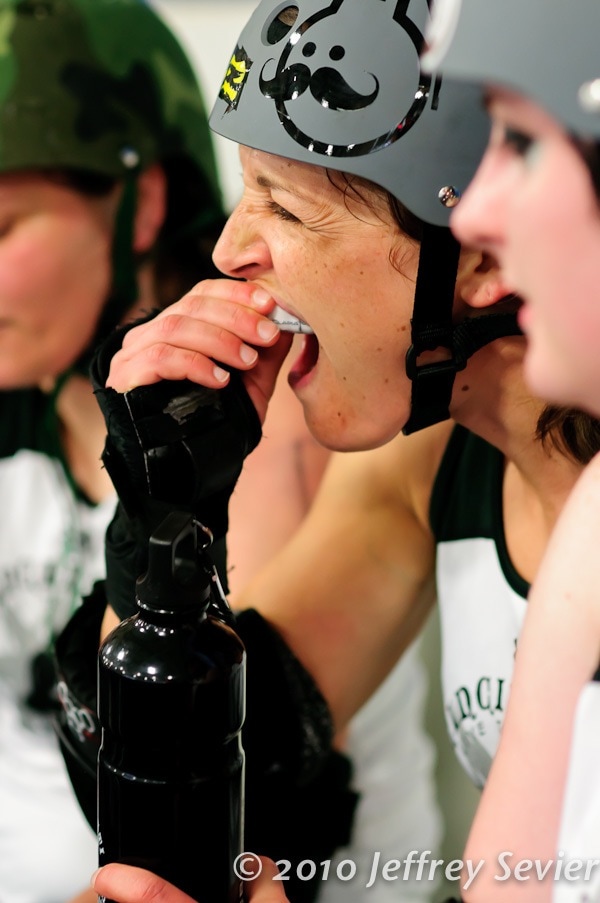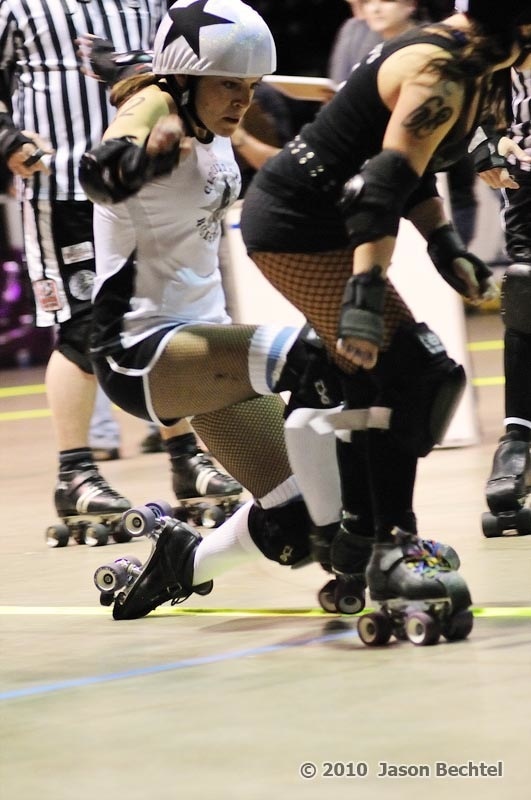When I first joined the league, I had never worn a mouthguard.
I couldn’t believe it when Sk8 Crime explained that wearing them was mandatory. We already had pads and a helmet…was a mouthguard really necessary?
Hop Devil and I rolled over to Target and bought the cheapest mouthguards we could find- a pair of $4 bulk boxes that we molded by putting into boiling hot water and then biting down into the soft plastic.
“Be sure to suck the remaining air from the guard so that a tight bond forms with the frontal teeth,” the directions on the guard’s packaging instructed.
It felt tight, but when I removed it and looked for the impressions, all I saw was a faint outline of my bite. Hops looked at me.
 “It schtichsh out a lowt.”
“It schtichsh out a lowt.”
“Ir knoww.”
“Durrde.”
Wearing the mouthguard felt weird then, but that was nothing compared to the difficulties we experienced while trying to sprint with them. I tried all sorts of ways to get away with sprinting without one, tucking it craftily inside of my left wrist guard where it would be out of sight and out of my hands; no dice. Captain Gorgeous or Pale Rider or the Librarian would cheerily remind us to pop them in every time endurance work was about to start and the team would dutifully obey, fishing them out of our helmet holes or our sports bra straps. I was convinced that this abominable practice of wearing mouthguards would be the end of my career. Not only did I feel slower than molasses when I had one in, but I sounded like Eeek! The Cat on a good day and Mushmouth on a bad one.
The vets had told us that we would soon get used to our equipment, and they were right; I feel almost naked without my mouthguard. Eventually, Hops and I both replaced our entry-level models with some sweet Gladiator guards that have our nicknames emblazoned on the sides. In fact, Celia Graves and Sk8 Crime rock their blinged guards like they’re sporting grillz (although Celia’s did recently get eaten by her dog, meaning she’s likely now sporting a more modest version). Safety becomes a part of the bravado: It’s a beautiful thing for skaters and parents of skaters alike.
 The same period of adjustment goes for close quarters—and I’m not even talking about the hitting part. Softball, tennis, and Ultimate Frisbee, my previous sports of trade, don’t involve using your teammates’ bodies as aids and weapons against the opposition. So the first time I felt one of my team’s jammers work her way through the pack by clutching at my jersey and using my hips to whip herself forward, it caught me off guard. When Trauma put 15 of us rookies into a tightly clustered pack, sat us down in a derby stance, and had us skate with our hands just above each other’s knees at boot camp, it felt cumbersome. And you can just imagine the wobbly uncertainty that gripped my mind and legs the first time one of my teammates put her hands on my butt and intentionally sent me careening to stop a jammer making a break to the outside!
The same period of adjustment goes for close quarters—and I’m not even talking about the hitting part. Softball, tennis, and Ultimate Frisbee, my previous sports of trade, don’t involve using your teammates’ bodies as aids and weapons against the opposition. So the first time I felt one of my team’s jammers work her way through the pack by clutching at my jersey and using my hips to whip herself forward, it caught me off guard. When Trauma put 15 of us rookies into a tightly clustered pack, sat us down in a derby stance, and had us skate with our hands just above each other’s knees at boot camp, it felt cumbersome. And you can just imagine the wobbly uncertainty that gripped my mind and legs the first time one of my teammates put her hands on my butt and intentionally sent me careening to stop a jammer making a break to the outside!
Besides touch, a second sense affected by close quarters is smell. Causally, the explanatory formula looks like this:
sweat + protective gear + dark storage bags + time = ick.
To my knowledge, reporters who interview our skaters haven’t yet added ick to the “by day/by night” theme that persists in many of the articles that cover our team, but they ought to consider it. E.g.: “By day, she is a wry but cheerful graduate student whose scent of choice is Crabtree & Evelyn’s ‘Nantucket’ perfume, which smells of spice and citrus; but no amount of body care accessory can cover the essence of horse that emanates from Bombtrack’s elbow pads as she skates the oval on Tuesday and Thursday nights.”
‘Eau d’Chevaux’ doesn’t really have a solution—washing pads can only help so much, and even then it’s just a momentary fix. However, one does discover pretty quickly that the moments you smell the gear of others are usually the ones that you spend standing still. In truth (as is the case with sharks) the key is to keep moving. Breezes save the day.
 The unfamiliar new experiences that I have described—the birth of fearlessness that is learning to move and revel in protective gear, the awareness that comes from knowing exactly how much space you have to move in a crowded pack, the knowledge that your body is a weapon for you and your teammates to use, and the acceptance of how vulnerable and exposed competition sometimes leaves you—are the result of making the switch from non-contact to full-contact sports.
The unfamiliar new experiences that I have described—the birth of fearlessness that is learning to move and revel in protective gear, the awareness that comes from knowing exactly how much space you have to move in a crowded pack, the knowledge that your body is a weapon for you and your teammates to use, and the acceptance of how vulnerable and exposed competition sometimes leaves you—are the result of making the switch from non-contact to full-contact sports.
Are the new conditions I have had to adapt to really so extraordinary? Perhaps not. For this rookie, though, to experience discomfort and vulnerability to the point that it becomes unextraordinary is something special. It is a new achievement and development in what has been a long lifetime of competition in sports for me.
All of us are motivated to compete for different reasons—some for thrills, some for personal fitness, some for the joy of team camaraderie, and some for flat-out glory. In my past sports careers, I’ve always enjoyed moments of athletic beauty and perfection– moments when I know I’m doing everything right, and I know it LOOKS right, and it’s going to turn out right.
But you know what I’ve enjoyed most about this, to date? The moments when I’ve felt vulnerable, scared, hurt, angry, frustrated—and I’ve been pushed by my team and my competitors to persevere anyway. The moments when I’ve been caught on camera making the most ridiculous faces because I’m freaked, tired, psyched in the heat of battle, the moments when I’ve felt new muscles pull, the moments my teammates have called me out, tactfully or with fire. The moments when I’ve fallen on my face in front of a crowd of 3,000 and had them all collectively groan, then cheer like mad as I hop to my feet.
Because they all get that the struggle, the FULL CONTACT—it’s the stuff of transformation.

